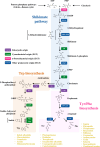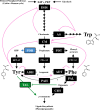Evolution of aromatic amino acid metabolism in plants: a key driving force behind plant chemical diversity in aromatic natural products
- PMID: 39343022
- PMCID: PMC11439500
- DOI: 10.1098/rstb.2023.0352
Evolution of aromatic amino acid metabolism in plants: a key driving force behind plant chemical diversity in aromatic natural products
Abstract
A diverse array of plant aromatic compounds contributes to the tremendous chemical diversity in the plant kingdom that cannot be seen in microbes or animals. Such chemodiversity of aromatic natural products has emerged, occasionally in a lineage-specific manner, to adopt to challenging environmental niches, as various aromatic specialized metabolites play indispensable roles in plant development and stress responses (e.g. lignin, phytohormones, pigments and defence compounds). These aromatic natural products are synthesized from aromatic amino acids (AAAs), l-tyrosine, l-phenylalanine and l-tryptophan. While amino acid metabolism is generally assumed to be conserved between animals, microbes and plants, recent phylogenomic, biochemical and metabolomic studies have revealed the diversity of the AAA metabolism that supports efficient carbon allocation to downstream biosynthetic pathways of AAA-derived metabolites in plants. This review showcases the intra- and inter-kingdom diversification and origin of committed enzymes involved in plant AAA biosynthesis and catabolism and their potential application as genetic tools for plant metabolic engineering. I also discuss evolutionary trends in the diversification of plant AAA metabolism that expands the chemical diversity of AAA-derived aromatic natural products in plants. This article is part of the theme issue 'The evolution of plant metabolism'.
Keywords: aromatic amino acid; aromatic natural products; enzyme evolution; negative feedback inhibition.
Conflict of interest statement
I declare I have no competing interests.
Figures




Similar articles
-
Harnessing evolutionary diversification of primary metabolism for plant synthetic biology.J Biol Chem. 2019 Nov 8;294(45):16549-16566. doi: 10.1074/jbc.REV119.006132. Epub 2019 Sep 26. J Biol Chem. 2019. PMID: 31558606 Free PMC article. Review.
-
The shikimate pathway and aromatic amino Acid biosynthesis in plants.Annu Rev Plant Biol. 2012;63:73-105. doi: 10.1146/annurev-arplant-042811-105439. Annu Rev Plant Biol. 2012. PMID: 22554242 Review.
-
A Three-Ring Circus: Metabolism of the Three Proteogenic Aromatic Amino Acids and Their Role in the Health of Plants and Animals.Front Mol Biosci. 2018 Apr 6;5:29. doi: 10.3389/fmolb.2018.00029. eCollection 2018. Front Mol Biosci. 2018. PMID: 29682508 Free PMC article. Review.
-
Evolutionary Diversification of Primary Metabolism and Its Contribution to Plant Chemical Diversity.Front Plant Sci. 2019 Jul 10;10:881. doi: 10.3389/fpls.2019.00881. eCollection 2019. Front Plant Sci. 2019. PMID: 31354760 Free PMC article. Review.
-
Aromatic Amino Acids: A Complex Network Ripe for Future Exploration.Trends Plant Sci. 2020 Jul;25(7):670-681. doi: 10.1016/j.tplants.2020.02.005. Epub 2020 Mar 13. Trends Plant Sci. 2020. PMID: 32526172 Review.
Cited by
-
Current and future perspectives for enhancing our understanding of the evolution of plant metabolism.Philos Trans R Soc Lond B Biol Sci. 2024 Nov 18;379(1914):20240253. doi: 10.1098/rstb.2024.0253. Epub 2024 Sep 30. Philos Trans R Soc Lond B Biol Sci. 2024. PMID: 39343013 Free PMC article.
-
Arabidopsis 3-Deoxy-d-Arabino-Heptulosonate 7-Phosphate (DAHP) Synthases of the Shikimate Pathway Display Both Manganese- and Cobalt-Dependent Activities.Plant Direct. 2025 Jan 21;9(1):e70037. doi: 10.1002/pld3.70037. eCollection 2025 Jan. Plant Direct. 2025. PMID: 39845276 Free PMC article.
-
The Taproot Acts as a Storage Organ During Rapeseed Vernalization.Physiol Plant. 2025 May-Jun;177(3):e70287. doi: 10.1111/ppl.70287. Physiol Plant. 2025. PMID: 40394819 Free PMC article.
References
Publication types
MeSH terms
Substances
Grants and funding
LinkOut - more resources
Full Text Sources

